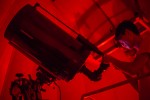UCLA researchers and space enthusiasts observed the moon’s craters through a telescope on the roof of the Mathematical Sciences Building in Saturday’s evening.
The UCLA Institute for Planets and Exoplanets hosted a moon observation event – one of hundreds held annually worldwide – to celebrate the scientific study and exploration of the moon, said Dave Milewski, a graduate student in earth, planetary, and space sciences.
NASA hosted the first International Observe the Moon Night in 2010. NASA encourages organizations and people all over the world to host similar events on Oct. 8 yearly.
[Related: Students create satellites for NASA]
Graduate students in the earth, planetary, and space sciences department set up four telescopes on the rooftop, which observers could use to see highlands and maria on the moon’s surface, said Milewski. Highlands are lighter regions of the moon’s surface and maria are dark planes.
Attendees could use UCLA’s 14-inch Schmidt Cassegrain telescope, which is one of the most advanced telescopes owned by UCLA, said earth, planetary, and space sciences professor David Jewitt.
That night, there was a quarter moon in the sky, Jewitt said. This phase of the moon is better for observation than a full moon because the reflection of the sunlight is not too strong and the craters appear clearer under the shadow, he said.
Attendees were also able to look through microscopes and observe moon dust collected by Apollo 11 and Apollo 16, said Michelle Jordan, a graduate student in earth, planetary, and space sciences. Additionally, researchers presented a meteorite display and people were able to ask questions about the origins and chemical compositions of the meteorites.
Jordan said one of the meteorite slabs was more than 3.6 billion years old.
The slab, which weighs about 14 grams, was a piece of a 440-gram rock that landed on Earth, probably due to an asteroid collision, Jordan said.
“It is an unusual and also precious piece of sample for scientists to study the chemistry composition of the moon’s surface without leaving the Earth,” Jordan said.
[Related: Couple loans unexpected find to UCLA Meteorite Gallery]
Amr Shahat, a graduate student in archaeology who attended the event, said he thinks the event was a great opportunity for space enthusiasts like him to look into the universe.
It enabled people to explore the moon closely instead of passively receiving knowledge from a lecture or a textbook, he said.
“We have always been seeing the moon with our naked eye,” Shahat said. “I am curious what the moon is actually like when we see it much closer through a telescope.
With the high resolution telescopes, Shahat was able to see the shapes of the craters and how they’re arranged on the moon’s surface.
“As an archaeologist, I learn about history of not only the Earth but also the moon too,” Shahat said. “I myself find it stunning to see and even to feel part of the moon’s history.”
The UCLA Institute for Planets and Exoplanets has been hosting the moon observation to echo the NASA International Observation the Moon Night since 2011.
[gmedia id=68]
